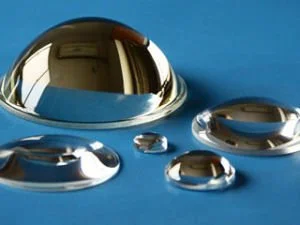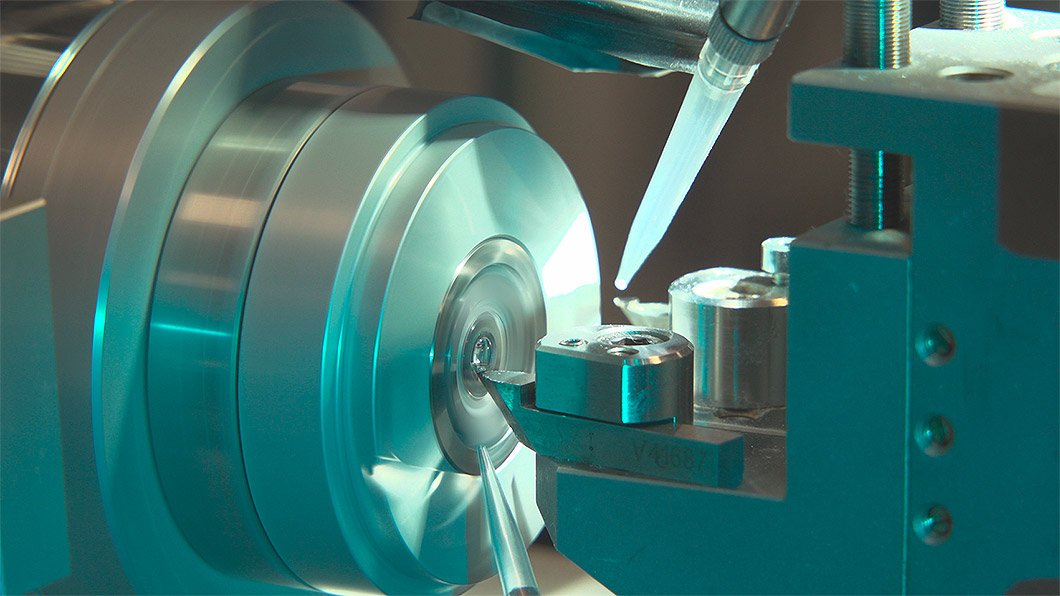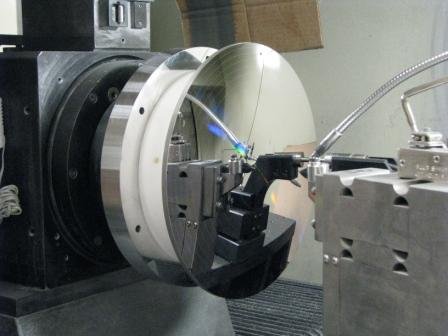A Comprehensive Guide to Aspheric Lenses
/some aspheric condenser lenses to feast your eyes on
Aspheric lenses are optical lenses that deviate from the ideal spherical shape. They are used to correct various types of aberrations, such as spherical aberrations, distortion, and field curvature, which are often present in traditional spherical lenses. The use of aspheric lenses can lead to improved image quality, reduced lens size, and increased system efficiency.
The spherical shape of traditional lenses is determined by the radius of curvature of the lens surface. In order for light to be focused correctly, the surface must be a perfect sphere. However, this shape can cause aberrations that limit the resolution and contrast of the image. Aspheric lenses are designed to overcome these limitations by modifying the shape of the lens surface to correct for aberrations.
Aspheric lenses can be made using a variety of materials, including glass, plastic, and other optical materials. Glass aspheric lenses are the most commonly used in high precision optical systems due to their durability and high index of refraction. Plastic aspheric lenses are more flexible, lighter, and less expensive than glass lenses, making them ideal for mass-produced consumer products such as digital cameras, smartphones, and projectors.
The production of aspheric lenses involves several steps, including the design and prototyping of the lens surface, molding or grinding of the lens surface, and coating of the lens surface to increase its transmission. The design of the aspheric surface is determined by mathematical equations that account for the desired correction of aberrations and the desired image quality. The lens surface can be molded or ground to the desired shape using a variety of techniques, including grinding, diamond turning, and injection molding.
Spherical Aberrations
Spherical aberrations occur because of the difference in the refractive index between the center and the edge of a spherical lens. Light passing through the center of the lens is focused to a single point, but light passing through the edge is not focused correctly, leading to a blurred image. This effect is more pronounced for lenses with a large aperture, such as camera lenses or telescopes.
Aspheric lenses solve this problem by modifying the shape of the lens surface. Instead of a spherical surface, aspheric lenses have a surface that deviates from a perfect sphere. This allows for a more precise control of the refractive index, resulting in a more accurate focus of light. The aspheric surface is designed using mathematical equations that account for the desired correction of aberrations and the desired image quality.
The use of aspheric lenses can result in improved image quality, with sharper and clearer images and increased resolution. Aspheric lenses can also reduce the size and weight of optical systems, as they can correct for multiple aberrations with a single lens. This is because aspheric lenses can reduce spherical aberrations, distortion, and field curvature, which are often present in traditional spherical lenses.
Another advantage of aspheric lenses is their ability to reduce chromatic aberrations. Chromatic aberrations occur when different colors of light are focused at different points, causing a rainbow-like effect around the edges of an image. Aspheric lenses can reduce this effect by controlling the refraction of light at different wavelengths, resulting in a more accurate and consistent focus for all colors of light.
Aspheric lenses are an important tool in the field of optics and can be used to correct various types of aberrations, including spherical aberrations. By modifying the shape of the lens surface, aspheric lenses can improve image quality, reduce the size and weight of optical systems, and increase the accuracy and consistency of the focus. With the increasing demand for high-quality imaging in fields such as medicine, photography, and astronomy, the use of aspheric lenses will continue to play an important role in the advancement of optical technology.
Mathematical Breakdown of Aspheric Lenses
The mathematical description of aspheric lenses is based on a mathematical model called a surface profile equation, which defines the shape of the lens surface.
The surface profile equation can be expressed as a polynomial or a more complex mathematical function. The coefficients of the polynomial or the parameters of the mathematical function are chosen to produce a lens surface that corrects for the desired aberrations.
One common mathematical representation of aspheric lenses is the conic section, which is defined by the equation:
z = Ax^2 + Bxy + Cy^2 + Dx + Ey + F
where x, y, and z are the coordinates of a point on the lens surface and A, B, C, D, E, and F are the coefficients that determine the shape of the surface. By adjusting the values of the coefficients, the lens surface can be designed to correct for specific aberrations.
Another mathematical representation of aspheric lenses is the aspheric polynomial, which is defined by the equation:
z = C(1 + k) * (r^2/R^2) + Ar^4 + Br^6 + Cr^8 + ...
where z is the height of the surface above the optical axis, r is the radial distance from the optical axis, R is the radius of curvature of the surface, C is the conic constant, k is the conic coefficient, and A, B, and C are the polynomial coefficients. The polynomial coefficients can be adjusted to correct for specific aberrations.
The mathematical description of aspheric lenses is based on a surface profile equation that defines the shape of the lens surface. This equation can be represented as a conic section or an aspheric polynomial, and the coefficients or parameters of the equation are adjusted to produce a lens surface that corrects for the desired aberrations. The use of mathematical models and simulations allows for precise control of the lens surface, leading to improved image quality and reduced aberrations.
An additional mathematical representation for the aspheric lens formula. Source: https://escooptics.com/blogs/news/concepts-in-light-and-optics-lenses-part-4-aspheres
Advantages of Aspheric Lenses:
Correction of Spherical Aberrations: Aspheric lenses are designed to reduce spherical aberrations, which cause blurred or distorted images, by modifying the shape of the lens surface. This results in sharper and clearer images with increased resolution.
Improved Image Quality: The use of aspheric lenses can result in improved image quality, with sharper and clearer images and increased resolution.
Reduced Size and Weight of Optical Systems: Aspheric lenses can reduce the size and weight of optical systems as they can correct for multiple aberrations with a single lens.
Reduced Chromatic Aberrations: Aspheric lenses can reduce chromatic aberrations, which occur when different colors of light are focused at different points, causing a rainbow-like effect around the edges of an image.
Increased Accuracy and Consistency of Focus: Aspheric lenses can increase the accuracy and consistency of the focus for all colors of light, resulting in a more accurate and consistent image.
Disadvantages of Aspheric Lenses:
Complex Design and Manufacturing Process: Aspheric lenses require a more complex design and manufacturing process compared to spherical lenses, which can lead to higher costs.
Fragility: Aspheric lenses are often made from thinner and lighter materials compared to spherical lenses, which can make them more fragile and susceptible to damage.
Alignment and Tolerance Requirements: Aspheric lenses have strict alignment and tolerance requirements during the manufacturing process, which can result in increased production costs and reduced yields.
Limited Availability: Aspheric lenses may not be available in certain sizes or configurations, which can limit their use in certain applications.
Aspheric lenses offer many advantages, such as the correction of spherical aberrations and improved image quality, but also have some disadvantages, including a complex design and manufacturing process, fragility, and limited availability. The choice between using aspheric lenses and spherical lenses will depend on the specific needs of the application and the trade-off between the benefits and limitations of each type of lens.
Surface Qualities
Aspheric lenses are precision optical components, and as such, they can be affected by various surface shape imperfections that can degrade their performance. Some of the main surface shape imperfections of aspheric lenses include:
Spherical Aberration: Spherical aberration is a type of optical aberration that occurs when light from a point source is not focused to a single point. In aspheric lenses, this can be caused by deviations from the desired surface shape or by variations in the lens material properties.
Astigmatism: Astigmatism is a type of optical aberration that occurs when light from a point source is focused to two separate points, rather than a single point. This can be caused by surface shape imperfections in aspheric lenses.
Coma: Coma is a type of optical aberration that causes light from a point source to be focused to a comet-like shape, rather than a point. This can be caused by surface shape imperfections in aspheric lenses.
Distortion: Distortion is a type of optical aberration that causes straight lines in the object plane to appear curved in the image plane. This can be caused by surface shape imperfections in aspheric lenses.
Surface Roughness: Surface roughness is a deviation from a smooth surface that can cause light scattering and reduced image quality.
Waviness: Waviness is a type of surface shape imperfection that can cause light scattering and reduced image quality.
Aspheric lenses can be affected by various surface shape imperfections, including spherical aberration, astigmatism, coma, distortion, surface roughness, and waviness. The degree and type of surface shape imperfections will depend on the lens design, the manufacturing process, and the lens material properties. Precise control of the surface shape is critical for achieving the desired performance in aspheric lenses.
as the old saying goes: an aspheric lens in the hand is worth two in the bush
Production Methods
The production methods for aspheric lenses vary depending on the lens design, the lens material, and the desired production volume.
Spherical Molding: Spherical molding is a production method that is used to produce simple aspheric lenses with low volume production runs. This method involves pressing a heated lens material into a spherical mold, which then deforms the lens material into the desired aspheric shape. The surface quality of the lens produced using this method is limited, and additional surface finishing is typically required to achieve the desired surface accuracy.
Lathe Cutting: Lathe cutting is a production method that is used to produce high-precision aspheric lenses with low volume production runs. This method involves turning a spherical lens blank on a lathe and then cutting the lens material to the desired aspheric shape. The surface quality of the lens produced using this method is limited, and additional surface finishing is typically required to achieve the desired surface accuracy.
Diamond Turning: Diamond turning is a production method that is used to produce high-precision aspheric lenses with low to medium volume production runs. This method involves using a diamond-tipped cutting tool to machine the lens material to the desired aspheric shape. Diamond turning allows for precise control of the lens surface, and the surface quality of the lens produced using this method is typically higher than that produced using other production methods.
Molding and Replication: Molding and replication is a production method that is used to produce aspheric lenses with high volume production runs. This method involves creating a mold of the desired aspheric shape and then using this mold to replicate the lens using a suitable lens material. The surface quality of the lens produced using this method depends on the quality of the mold, and additional surface finishing may be required to achieve the desired surface accuracy.
Freeform Optics: Freeform optics is a production method that is used to produce complex aspheric lenses with low to medium volume production runs. This method involves using advanced computer-controlled machinery to machine the lens material to the desired aspheric shape. The surface quality of the lens produced using this method is typically higher than that produced using other production methods, and it allows for precise control of the lens surface.
In conclusion, the production methods for aspheric lenses vary depending on the lens design, the lens material, and the desired production volume. Methods such as spherical molding, lathe cutting, diamond turning, molding and replication, and freeform optics are used to produce aspheric lenses with varying levels of precision and surface quality. The choice of production method will depend on the desired production volume, the lens design, and the desired surface accuracy and quality.
Application Examples
Aspheric lenses are precision optical components that have a wide range of applications across various fields. Some of the main application examples of aspheric lenses are described below.
Photography and Imaging: Aspheric lenses are commonly used in cameras and other imaging devices to improve image quality and reduce optical aberrations. They are used in the manufacture of camera lenses, microscopes, and other imaging systems. Aspheric lenses provide improved resolution and sharpness compared to traditional spherical lenses and are commonly used in high-end camera lenses.
Laser Systems: Aspheric lenses are commonly used in laser systems to collimate laser beams and focus the laser light to a small spot. They are used in the manufacture of laser pointers, laser cutting machines, and other laser-based applications. Aspheric lenses provide improved beam quality and beam stability compared to traditional spherical lenses, making them an essential component in many laser systems.
Medical Devices: Aspheric lenses are commonly used in medical devices, such as endoscopes, to provide improved image quality and reduced distortion. They are also used in ophthalmic lenses, such as contact lenses and intraocular lenses, to correct visual aberrations and improve visual acuity.
Scientific Instruments: Aspheric lenses are commonly used in scientific instruments, such as telescopes and spectrometers, to provide improved image quality and reduced distortion. They are used in the manufacture of astronomical telescopes, microscopes, and other scientific instruments. Aspheric lenses provide improved resolution and accuracy compared to traditional spherical lenses and are an essential component in many scientific instruments.
Display Technology: Aspheric lenses are commonly used in display technology, such as projectors and head-mounted displays, to provide improved image quality and reduced distortion. They are used in the manufacture of projectors, virtual reality and augmented reality displays, and other display-based applications. Aspheric lenses provide improved resolution and image quality compared to traditional spherical lenses and are an essential component in many display-based applications.
Aspheric lenses are widely used in a variety of applications across various fields, including photography and imaging, laser systems, medical devices, scientific instruments, and display technology. Aspheric lenses provide improved resolution, accuracy, and image quality compared to traditional spherical lenses, making them an essential component in many precision optical systems.
Parting Thoughts
Firebird Optics provides a range of various aspheric lenses with varying materials, focal lengths, diameters as well as optical coatings. If you don’t find what you need feel free to drop us an e-mail at info@firebirdoptics.com.
Here’s to your success!
Firebird Optics










